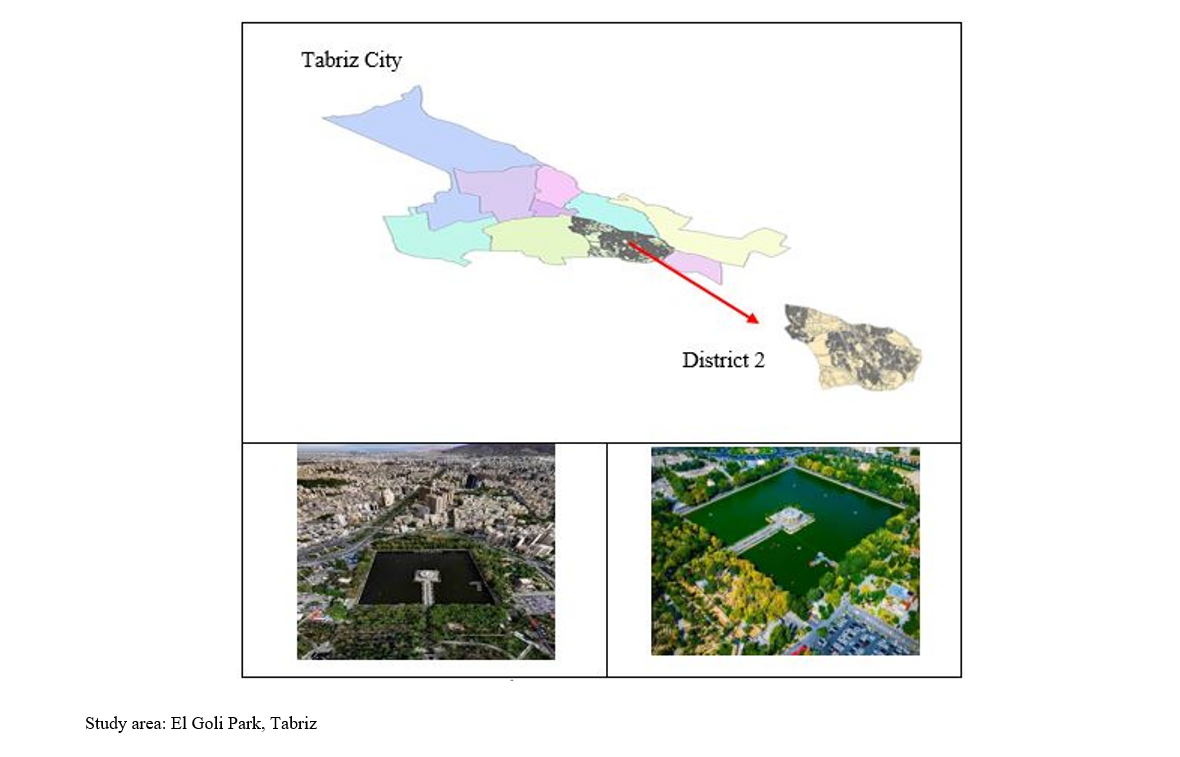An Analysis of the Social Dimensions of Sustainable Urban Public Spaces with Emphasis on Users’ Perception (Case Study: El Goli Park, Tabriz)
Keywords:
El-Goli Park, Lefebvre's theory, sustainable social development, Tabriz, urban public space, user perceptionAbstract
Urban public spaces are one of the key elements of the social and physical structure of cities, which play an important role in improving the quality of life, spatial justice, and sustainable development. The aim of this study is to analyze the social dimensions of sustainable development of urban public spaces with an emphasis on user perceptions. The theoretical framework of the study is based on Henri Lefebvre’s theory of “social production of space,” which considers space to include three dimensions: perceived, Conceived, and lived in this regard, the indicators obtained based on the theorists' perspectives were used to measure different dimensions of space. The present study was conducted in the field using a Likert-scale questionnaire. The statistical population consisted of four groups of users of El Goli Park in who were selected by random sampling. The data were analyzed using descriptive statistical tests and the Kruskal-Wallis test in SPSS software. The results of the analysis indicate that users' evaluations of the three dimensions of space differ from each other. The highest rankings were assigned by residents in the perceived and conceived dimensions of space, followed closely by user's evaluation of the lived space dimension, and both experts and students had lower scores. These findings were consistent with Lefebvre's theory about the importance of lived experience, place belonging and social status in our perception of space. The authors point to the importance of engaging with the mental, emotional and social dimensions of space in public policymaking and design of public spaces, they also give several key recommendations for participatory design, improving the quality of life of space, and ongoing evaluation with a focus on user experience.
References
A.B. Savchenko, and T.L.Borodina, "Green and digital economy for sustainable development of urban areas". Regional Research of Russia, vol.10, no.4, pp. 583-92. 2020. https://doi.org/10.1134/S2079970520040097
C. Li, T. Lu, B. Fu, S. Wang and J. Holden, "Sustainable city development challenged by extreme weather in a warming world". Geography and sustainability, vol. 3, no.2, pp.114-118, 2022. https://doi.org/10.1016/j.geosus.2022.04.001
H. Hataminejad, and A.Sharifi, "Examines the role of urban tourism development on sustainable urban development (Case study: Sanandaj)". Urban Tourism, vol. 2, no.1, pp.61-74, 2015. DOI: 10.22059/jut.2015.54066.
H. Barzegar, "Spatial identity of historic cities based on Lefebvre's spatial triad (Case: Kashan)," (in Persian), Journal of Urban Identity, vol. 16, no. 4, pp. 23-36, 2022.
A. Heidari, "Social effectiveness of public space development in the Sabzeh-Meydan pedestrian zone of Zanjan," (in Persian), Journal of Urban Planning, vol. 10, no. 1, pp. 50-68, 2020.
F. M. Abella, Y. Kim, and L. Wang, "Urban design, public spaces, and social cohesion: Evidence from VR experiments," Environment and Behavior, vol. 52, no. 4, pp. 512-534, 2020.
C. Garau and V. M. Pavan, "Evaluating urban quality: Indicators and assessment tools for smart sustainable cities," Sustainability, vol. 10, no. 3, p. 575, 2018, doi: 10.3390/su10030575.
F. Wiedmann and A. M. Salama, "Mapping Lefebvre's theory on the production of space to an integrated approach for sustainable urbanism," in The Routledge Handbook of Henri Lefebvre, the City and Urban Society. London: Routledge, 2019, pp. 346-354.
B. M. Napoletano, B. Clark, J. B. Foster, and P. S. Urquijo, "Sustainability and metabolic revolution in the works of Henri Lefebvre," World, vol. 1, no. 3, pp. 300-317, 2020, doi: 10.3390/world1030021.
H. Ghulyan, "Lefebvre's production of space in the context of Turkey," Cities, vol. 85, pp. 67-74, 2019, doi: 10.31235/osf.io/r85v9.
M. Mahmoudzadeh, "Ecological analysis of urban parks in Tabriz with an emphasis on environmental indicators," (in Persian), Environmental Planning Journal, vol. 11, no. 2, pp. 77-91, 2020.
S. Ghanbari, "Comparative study of pedestrian-friendly indicators in Tarbiat and Valiasr pedestrian streets in Tabriz," (in Persian), Journal of Traffic and City, vol. 7, no. 4, pp. 42-58, 2020.
M. Rahimi and F. Sabouri, "The impact of climate on mental schemas and spatial perception in El-Goli Park, Tabriz," (in Persian), Journal of Climatic Architecture, vol. 9, no. 3, pp. 29-42, 2018.
S. Naheed and S. Shooshtarian, "The role of cultural heritage in promoting urban sustainability: A brief review," Land, vol. 11, no. 9, p. 1508, 2022, doi: 10.3390/land11091508.
Z. Allam, A.Sharifi, S.E. Bibri, D.S. Jones, and J. Krogstie, "The metaverse as a virtual form of smart cities: Opportunities and challenges for environmental, economic, and social sustainability in urban futures". Smart Cities, vol.5, no.3, pp.771-801, 2022.
M.I. El-belkasy, and S.A.Wahieb, Sustainable conservation and reuse of historical city center applied study on Jeddah—Saudi Arabia. Sustainability, vol.14, no.9, p.5188, 2022. https://doi.org/10.3390/su14095188
H. Xu, C. Li, Y. Hu, S. Li, R. Kong, and Z. Zhang, "Quantifying the effects of 2D/3D urban landscape patterns on land surface temperature: A perspective from cities of different sizes," Building and Environment, vol. 233, p. 110085, 2023, doi: 10.1016/j.buildenv.2023.110085.
D. Hardilla and B. Dewancker, "Correction: Study of Public Space Use and Design based on Japanese and Foreign Perceptions," Environmental Science & Sustainable Development, pp. 27-35, 2023, doi: 10.21625/essd.v8i4.983.
N. Sonobe, "Understanding the social inclusion of migrants in Australia-highlighting the interplay between measurable outcomes and individual perceptions," 2023.
I. Di Ruocco, A. D'Auria, R. R. D'Alterio, and A. De Rosa, "A Framework for a User-Perception-Based Approach to Integrate Landscape Protection in Soft Mobility Planning," Land, vol. 12, no. 5, p. 1048, 2023, doi: 10.3390/land12051048.
S. W. Lee and K. Xue, "An integrated importance-performance analysis and modified analytic hierarchy process approach to sustainable city assessment," Environmental science and pollution research, vol. 28, no. 44, pp. 63346-63358, 2021, doi: 10.1007/s11356-021-15235-0.
N.H. Sari, "Communication approaches for participatory planning and civic engagement in sustainable governance systems: a study of social communicative behaviour in Indonesia" (Doctoral dissertation), Newcastle University, 2022. https://theses.ncl.ac.uk/jspui/handle/10443/5783

Downloads
Published
Submitted
Revised
Accepted
Issue
Section
License
Copyright (c) 2023 Mostafa Basiri (Corresponding author)

This work is licensed under a Creative Commons Attribution-NonCommercial 4.0 International License.











